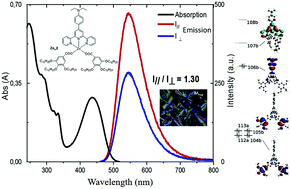Very intense polarized emission in self-assembled room temperature metallomesogens based on Zn(ii) coordination complexes: an experimental and computational study†
Abstract
Three room-temperature metallomesogens based on Zn(II) cations pentacoordinated by different chelating N^N^N terpyridines and two monodentate gallate co-ligands were designed and synthesized. Depending on the terpyridine ligand's tip functionality, the complexes self-assemble into either a 3D hexagonal mesophase or into a columnar hexagonal mesophase. A systematic study between the structure (molecular architecture, arrangement of the molecules and columns, and chains in both types of mesophases) and photophysical properties (emission maxima and yields, lifetimes of the excited states in the mesophase), correlated with investigations of single molecules in solution, was conducted. Remarkably, one complex exhibited a record quantum yield of 95.0% in solution, while in the mesophase, despite quenching due to the radiative deactivation from the ILCT state, still retained a considerable emission yield of ϕ = 20.2%. The polarized emission of an oriented film, determined for the first time in columnar metallomesogens, shows a dichroic emission ratio (I||/I⊥) of 1.30. DFT and TDDFT computational studies confirmed the origin of the observed fluorescence anisotropy from the transition dipole moment oriented along the C2 symmetry axis of the molecule combined with a high level of order in the 3D mesophase.



 Please wait while we load your content...
Please wait while we load your content...